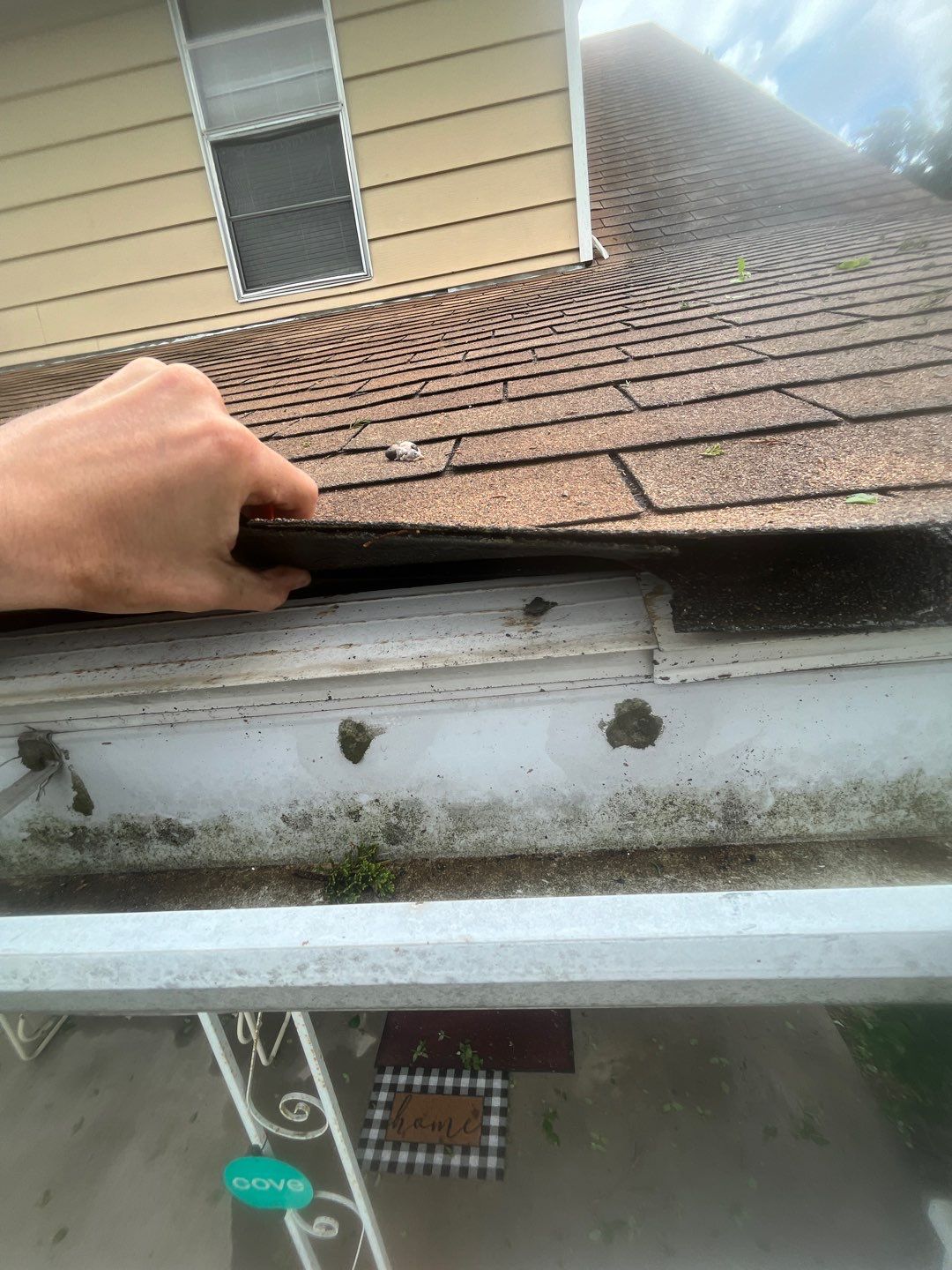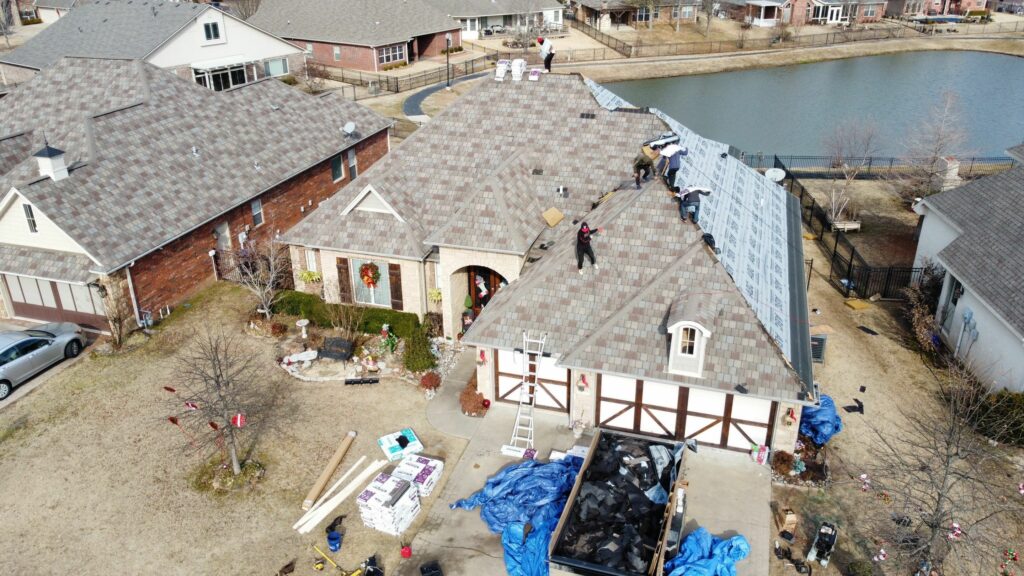What’s the Timeframe Needed for a Roof Replacement?
 As a homeowner, anticipating the time required for a roof replacement is not only a matter of curiosity but a necessity for effective planning. It is a process that hinges on a complexity of factors, from the initial inspection and measurement proceedings to design decisions and material selection.
As a homeowner, anticipating the time required for a roof replacement is not only a matter of curiosity but a necessity for effective planning. It is a process that hinges on a complexity of factors, from the initial inspection and measurement proceedings to design decisions and material selection.
The timeframe is invariably dictated by contract terms and influenced by elements such as roof accessibility, pitch, height, material choice, home size, and replacement technique. While it is true that distinct roofing materials require different durations for replacement, there is more to this equation.
As we proceed, we will uncover how these factors interplay to determine the duration of a roof replacement project.
If you’re grappling with structural issues in your roof or contemplating a fresh installation, our premier roof repair company in Arkansas are right at your service. At Luck Roofing, we offer top-notch roofing solutions to Fort Smith and the surrounding regions. Feel free to reach us at (479) 397-2228 for professional advice. Your project is worthy of the exceptional standards and dependability we provide.
Key Takeaways
- The timeline for roof replacement is influenced by factors such as the chosen roofing materials, size and current damage of the house, steepness of the roof, access to the roof, and weather conditions.
- The type of roofing material, size and complexity of the roof, weather conditions, accessibility to the roof, and necessity for additional roof repairs are determining factors of the replacement time.
- The initial estimate process involves contacting roofing companies, scheduling the initial estimate, conducting a roof inspection, and receiving a quotation of costs.
- Scheduling and service details include aligning availability with the roofing company, considering the installation process duration, timeframe for inspection and estimates, peak season and off-season scheduling, and the impact of roofing material choice.
Understanding Roof Replacement Timeline
 How long does it take to replace a roof? This question is crucial for homeowners planning a roof replacement, as the timeline can vary significantly depending on several factors including the type of roofing material used, the size and condition of the house, roof accessibility, steepness of the roof, and weather conditions.
How long does it take to replace a roof? This question is crucial for homeowners planning a roof replacement, as the timeline can vary significantly depending on several factors including the type of roofing material used, the size and condition of the house, roof accessibility, steepness of the roof, and weather conditions.
The roof replacement timeline is influenced by the chosen roofing materials. For instance, asphalt shingles typically require 1-3 days while tile can require up to 6-12 days.
The size and current damage of the house also play a vital role in the replacement process. Larger homes and those with extensive storm damage require a lengthier timeline for roof replacements.
The steepness of the roof is another key determinant. Roofs with a greater pitch necessitate additional safety measures, thereby extending the timeline.
Access to the roof, dictated by factors like surrounding landscaping and urban congestion, is crucial for a smooth replacement process.
Lastly, weather conditions significantly impact how long does it take to replace a roof. Work cannot proceed during rain, snow, or freezing temperatures, which can cause delays in the roof replacement timeline.
Determining Factors Of Roof Replacement Time
In determining the timeline for a roof replacement, several factors come into play.
One significant factor is the type of roofing material. Different materials require different amounts of time for replacement. For example, asphalt shingles typically require 1-3 days, while wooden shingles may need between 6-8 days.
Other factors that contribute to the timeline include the size and complexity of the roof. Greater dimensions and complex designs can extend the replacement time.
Weather conditions also play a role in the timeline. Unfavorable weather, particularly in winter and rainy seasons, can cause delays in the replacement process.
Accessibility is another factor that can affect the timeline. Issues such as landscaping, urban density, or lack of parking can slow down the process if they hinder access to the roof.
The necessity for additional repairs is another consideration. If underlying damage is discovered during the replacement process, additional time may be needed for repairs before the new roof can be installed.
Lastly, the replacement method itself can impact the timeline. Some roofs may require a complete tear-off and rebuild, while others allow for overlaying new materials on the old ones.
Taking all of these factors into account is crucial when determining how long a roof replacement will take.
Roof Replacement: The Initial Estimate
Commencing the process of roof replacement typically involves an initial estimate, which is usually scheduled within a week or two after contacting roofing companies. This initial estimate is a crucial step in the timeline of a roof replacement, where a roofing contractor conducts a thorough roof inspection. The inspection informs the contractor about the materials needed, the complexity of the job, and the overall cost to the client for a new roof.
Can My Insurance Pay For A Roof Replacement?
Understanding your insurance policy’s coverage is key when it comes to having insurance for your roof replacement. Prior to lodging a roof insurance claim or making a decision to replace your roof, it’s vital to go over your policy and fully grasp what is covered and what isn’t. Quite a few homeowners are shocked to learn that their insurance company may not cover a roof replacement if certain criteria are not met.
The table below provides a breakdown of the initial estimate process:
| Steps | Description | Duration |
|---|---|---|
| Contact | Reach out to roofing companies | Immediate |
| Schedule | Set a date for the initial estimate | 1-2 weeks |
| Inspection | The contractor assesses the roof’s condition | 1-2 hours |
| Quotation | The contractor gives an estimate of costs | 1-2 days |
The size of your home and the type of roofing materials chosen can significantly influence these durations. Unforeseen circumstances such as extreme weather conditions can also impact the scheduling and completion of a roof replacement. Remember, replacing a roof is a significant investment, so it’s essential to understand every step involved.
Scheduling And Service Details
Once the initial estimate has been completed and a contract has been agreed upon, the next critical step in a roof replacement process is to finalize the scheduling and service details. The complexity of these details can influence how long does it take to replace a roof.
Typically, scheduling the roofing service takes a few days. This involves aligning the availability of the roofing company with your schedule. The actual installation process usually takes a few days to complete, but this can vary depending on several factors.
The roofing company generally sends an inspector within a few days of contact and takes a week or two to schedule estimates.
The replacement process cannot begin on the same day unless it is an emergency.
Peak season for replacing roofing is from late spring through early fall, which may affect scheduling.
Off-season scheduling can often lead to quicker service.
The choice of roofing materials affects the timeline, with different materials such as asphalt, wood, slate, concrete, metal, and tile having varying replacement timelines.
Understanding these service details is crucial to set realistic expectations for your roof replacement.
The Role Of Roofing Materials

Roofing material chosen plays a critical role in the timeline and process of roof replacement. The role of roofing materials cannot be overstated, as they directly influence the duration and complexity of the project. Common roofing materials, such as asphalt shingles, require less time to install compared to materials like slate or tile.
When replacing a roof with asphalt shingles, for instance, the old roofing material is typically removed before installing new shingles directly onto the roof decking. This process is relatively quick, making asphalt shingles a popular choice for many homeowners.
However, the choice of roofing material is not just about the time it takes to install. It also impacts the longevity, cost, and aesthetic appeal of the roof. Therefore, homeowners must carefully consider these factors when choosing a roofing material.
| Roofing Material | Installation Time | Other Considerations |
|---|---|---|
| Asphalt Shingles | 1-2 days | Affordable, easy to install, but shorter lifespan |
| Wood Shingles | 3-4 days | Natural look, but requires maintenance |
| Slate Tiles | 6-12 days | Long lifespan, but more expensive and longer install time |
Impact Of Home And Roof Size
Significantly affecting the timeline of roof replacement, the size and complexity of a home and its roof present a crucial factor to consider in the overall process. The impact of home and roof size can be considerable, especially for larger homes. The larger your home, the more materials and time are required to complete the project.
This aspect is tightly linked with the size of your roof, as a more extensive roof area naturally prolongs the duration of the replacement process. Roof design also has a key role in this equation. Complex designs, with numerous penetrations, valleys, or steep areas, can add to the time needed for replacement.
To understand this further, consider the following points:
- Larger homes typically have larger roofs, requiring more materials and time for replacement.
- The complexity of the roof design, including elements like valleys or steep areas, can impact the duration of the project.
- Various roof designs require different amounts of materials, affecting the overall time for completion.
- Roof accessibility can also impact the efficiency of the replacement process.
- The choice of roofing material can significantly affect the installation time, and thus the completion timeline.
The Influence Of Roof Accessibility
Navigating the challenges of roof accessibility plays a pivotal role in determining the timeline of a roof replacement project. Roof accessibility refers to the ease with which a contractor can access your roof to carry out the necessary work. Factors that can make a roof difficult to access include its height, pitch, and surrounding features such as trees and other structures.
If your property has lots of landscaping or limited space, it can create logistical challenges for the contractor to access the roof. This includes maneuvering heavy equipment and materials to and from the worksite. In such cases, extra planning and precautions are required, which may extend the overall timeline of the project.
On the other hand, a roof that is easy to access can expedite the replacement process. The contractor can work more efficiently without the hindrance of accessibility issues, thus shortening the project’s duration. Therefore, understanding and addressing the accessibility of your roof can significantly influence the time it takes to replace your roof.
Dealing With Weather And Delays
While considering the influence of roof accessibility on the project’s timeline, it is equally crucial to take into account the potential issues related to weather and unexpected delays. Dealing with weather and delays can require additional time and greatly affect the timeline.
Weather conditions, especially rain in the forecast, can stall the process. Roofing is a task best done under clear skies since wet conditions might compromise both the safety of the workers and the quality of work.
Here are some factors to consider:
- Weather and Time of Year: The timeline can be affected by seasonal conditions and daily weather fluctuations.
- Roofing Material and Design: Certain materials and designs may require ideal weather conditions for installation.
- Accessibility of the Roof: Weather can impact accessibility, particularly in cases of heavy snow or rain.
- Unexpected Damage and Delays: Inclement weather can reveal previously unnoticed damage, requiring unplanned repair work.
- Peak and Off-Season Scheduling: Weather patterns during peak roofing season can result in scheduling conflicts and delays.
Understanding these factors can help homeowners plan effectively and manage expectations when replacing a roof.
Choosing Between DIY And Professionals
When it comes to replacing a roof, homeowners are faced with a critical decision: to embark on a do-it-yourself project or hire professional contractors. If you opt for DIY, consider the complexity of the project and your level of expertise. While this option can save money, it requires substantial planning, precise skills, and strict adherence to safety measures. Moreover, DIY projects may lack the warranty and certain efficiencies that come with professionals.
Roofing companies, on the other hand, bring extensive expertise and specialized equipment to the table. They can efficiently replace your roof, ensuring quality workmanship and compliance with building codes. Moreover, hiring professionals can minimize safety risks and provide warranties that offer long-term peace of mind.
Ultimately, the choice between DIY and professionals when replacing your roof should be made after considering a variety of factors. These include your comfort level with roofing tasks, the scope of the project, and the potential costs. Remember, while DIY may seem cheaper initially, the risk of errors can lead to additional expenses.
And Finally
In conclusion, the timeline for roof replacement is influenced by various factors including:
- Roofing materials
- Home and roof size
- Roof accessibility
- Potential weather delays
The choice between engaging professionals or embarking on a DIY project also plays a significant role.
Also Read:
- Roof Restoration Vs. Replacement-Which Option To Choose
- Roof Replacement Vs. Roof Repair: What’s The Best Option?
It is therefore crucial for homeowners to understand these factors and their impact on timelines and costs, to enable better planning and management of roof replacement projects.
Michael Overzat
Michael Overzat resides in Fort Smith, Arkansas with his wife and three kids. He enjoys to hike, skateboard, write, and get involved in charity organizations. He was originally born in Maryland. He has worked within the roofing industry for 5 years and is very active within the industry by attending conferences, masterminds, etc. His vision is to create a multi-state organization that has a customer centric model. He's worked for some of the biggest names in the industry and hopes to create a more people focused model for the roof replacement process.
